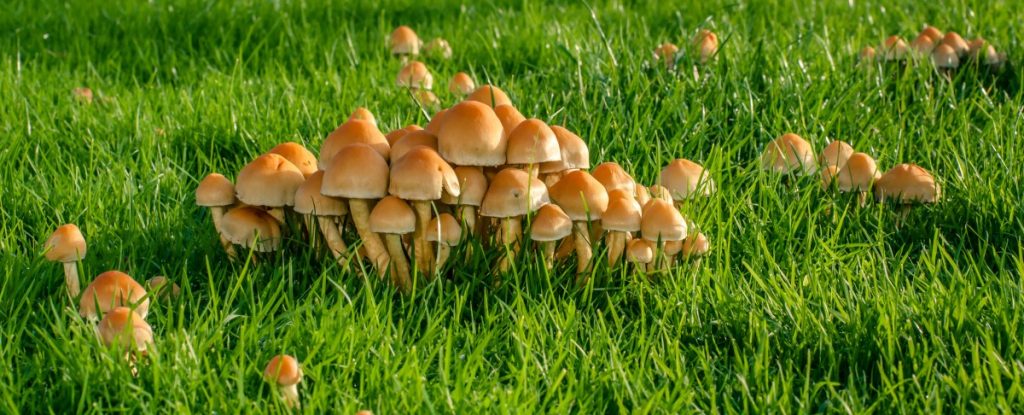For many people, the mushrooms that pop up in their backyards are mysterious, intriguing and sometimes worrying, and raise the question, “Why are mushrooms growing in my backyard?”
Beautiful and unique backyard mushrooms are intriguing but some are also poisonous, so it’s always best not to touch or eat any unknown wild mushrooms that appear in your yard.
But, most common backyard mushrooms are harmless and play an important role in your backyard ecosystem.
In this article, we explore what backyard mushrooms are, why they’re growing in your garden and how to identify them.
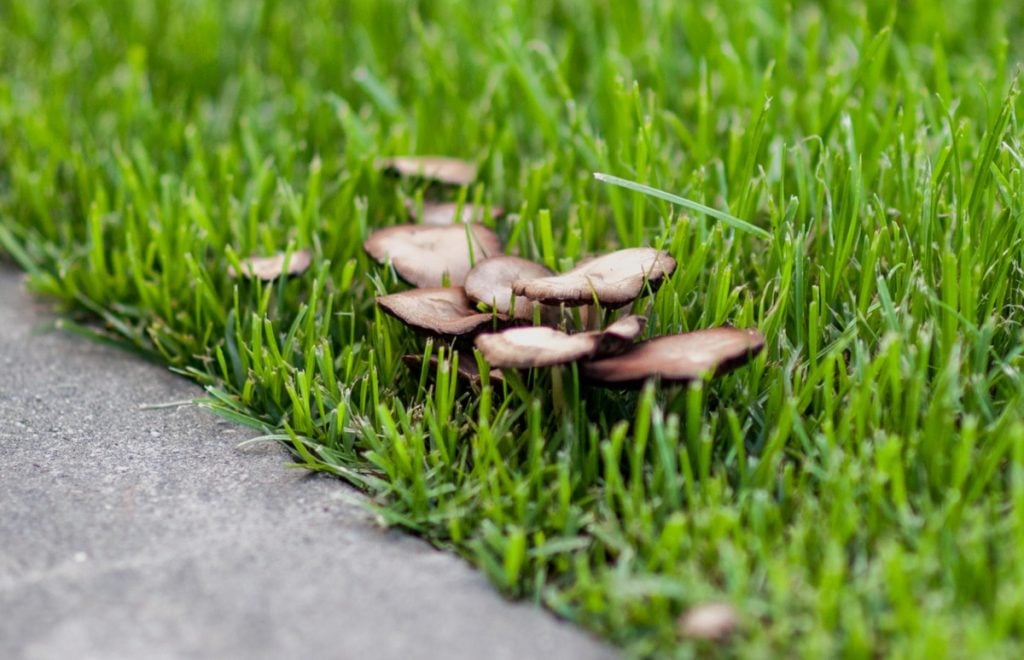
What Are Backyard Mushrooms?
Backyard mushrooms are the fruiting bodies of an underground fungus growing under the soil in your backyard.
These fungi play a crucial role in breaking down the woody organic material in the soil, making it more productive.
If you have mushrooms in your backyard, it’s usually a sign of healthy soil with lots of organic material that promotes the growth of lawn, shrubs and trees.
Why Do Mushrooms Grow in Backyards?
Most of the time, the fungi in your backyard stay hidden underground while feeding on the organic material in the soil.
They can stay dormant for years. But when conditions are right, they produce reproductive structures that we call mushrooms.
By this time, they’re well-established below the surface, and the mushrooms are simply a sign that there’s a thriving fungus in your backyard.
Mushrooms can grow so quickly that they often pop out of the ground overnight and seem to appear out of nowhere.
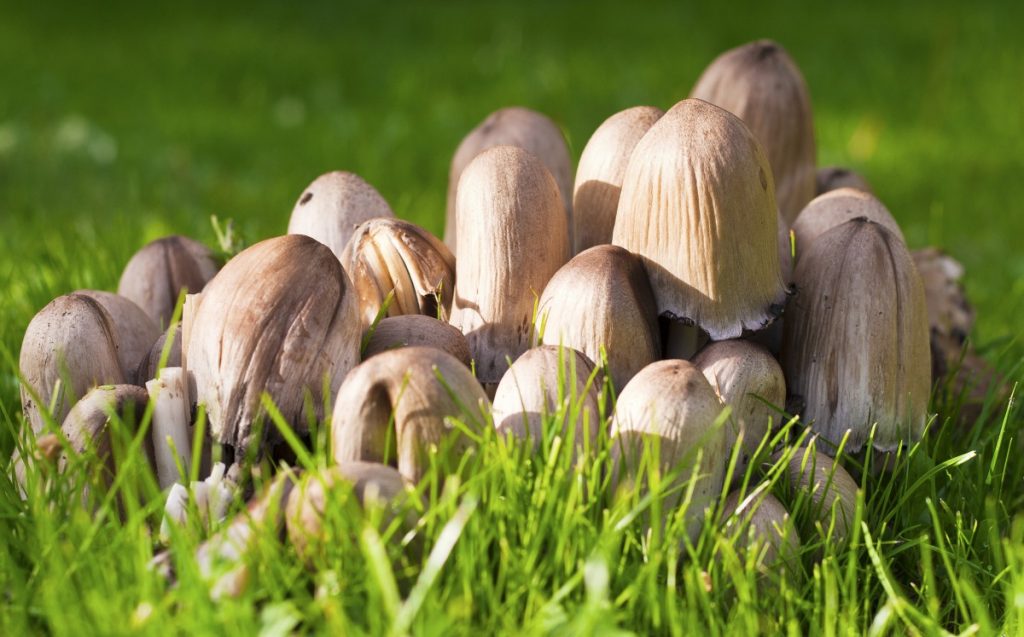
Why Do I Have Mushrooms Growing in my Yard?
If you have mushrooms growing in your backyard, it means the conditions are right for the underground fungus to reproduce.
The soil has enough food for the underground mycelium, and the temperature and humidity levels in the area are suitable for the fungus to fruit.
Mushrooms need specific conditions to thrive and reproduce, including:
- An environment rich in organic matter: Buried wood, old tree stumps, decaying leaf mulch, pet waste and other rotting organic matter are the perfect food for mushrooms.
The more organic matter in your backyard, the more mushroom-producing fungi you will have.
- Damp, humid conditions: Mushrooms thrive in moist environments with high humidity levels, which is why they often pop up after heavy rains.
They’re also commonly found in poorly draining or damp areas of your backyard.
- Shady, sheltered or protected spaces: Mushrooms tend to grow in shady spots sheltered from winds or in areas with lots of mulch, leaves, or compost.
If these conditions are present in your yard, you’ll more than likely have backyard mushrooms.
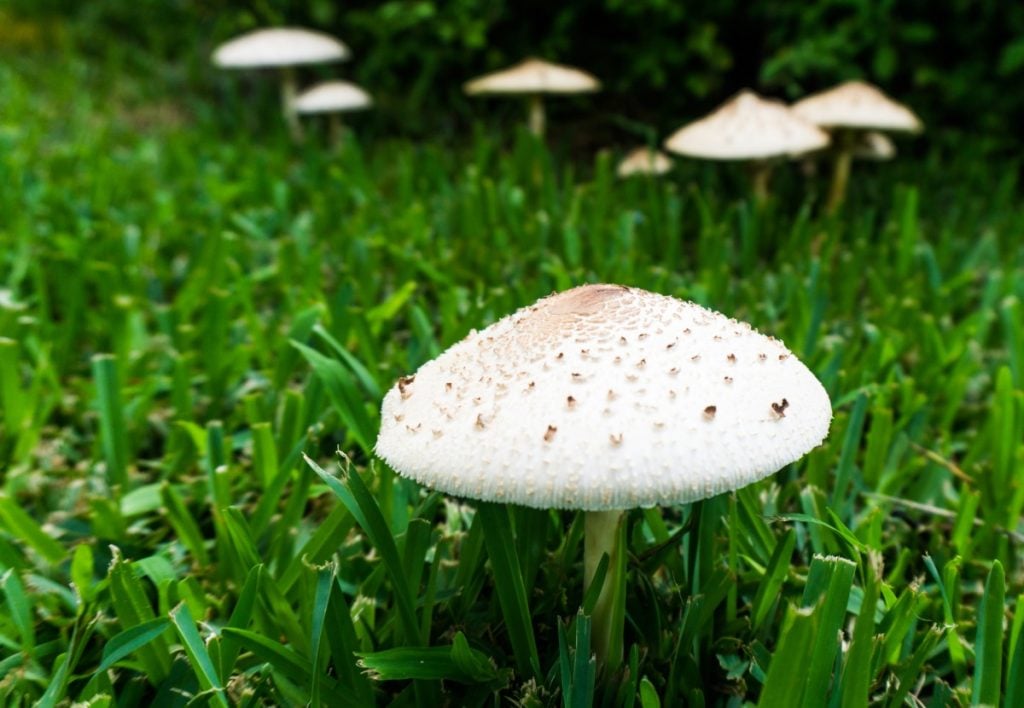
Common Backyard Mushrooms
Wild mushrooms that grow in forests and meadows vary drastically from one country to the next.
But when you visit gardens in cities across North America, you’ll often find the same familiar backyard mushrooms. And mycologists have noted that this is a global phenomenon.
So, even though types of mushrooms vary from country to country, there’re common species that thrive worldwide in gardens with temperate climates.
Here are some of the common mushrooms found growing in backyards:
1. Ringless Honey Mushroom (Armillaria Tabescens)

The ringless honey mushroom is the same family as the honey mushroom, and both are very common in urban yards in late summer to fall.
They both have dry honey-colored caps on long stems often fused at the base. The only notable difference between the two is that the ringless honey mushroom does not have a ring on its stem. Hence the name.
These mushrooms grow in clusters at the base of trees or stumps, often in large quantities. They sometimes look like they are growing out of the ground, but they’re actually growing on roots or other buried wood.
Honey mushrooms are edible, but you should always cook them before you eat them. Even after cooking, some people still experience cramps, nausea and stomach pain.
Ringless honey mushrooms also have some toxic and even deadly look-alikes. So an experienced forager should confirm their identification if you plan on eating them.
2. Field or Meadow Mushroom (Agaricus Campestris)
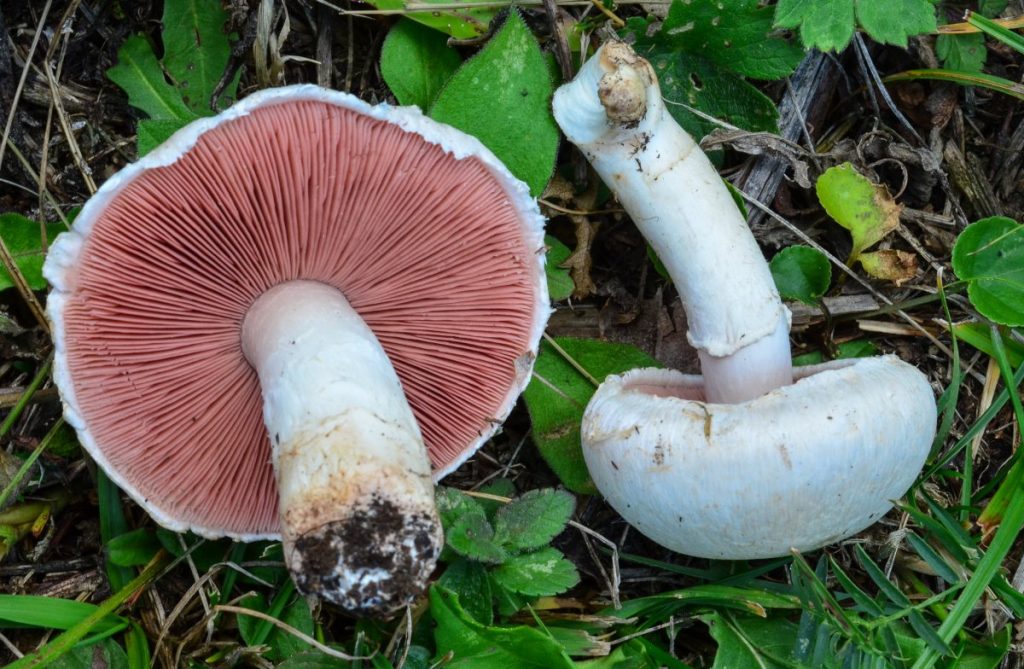
The field or meadow mushroom is one of the most eaten wild mushrooms in Britain and Ireland. It’s closely related to the common button mushroom and has a similar taste and texture.
You’ll find them growing alone or in groups, arcs or gradually expanding rings called fairy rings, in fields, meadows and lawns.
Their caps are creamy-white and 1-4 inches (3-10cm) in diameter. The caps edges usually remain down-turned or rolled inwards even when the mushroom is mature.
When you cut the cap, the flesh should be thick and white, sometimes turning slightly pink but should never turn yellow.
Like portobellos, their gills start out deep pink becoming brown and eventually dark brown when the mushroom matures.
There are several species of mushrooms that you may confuse with field mushrooms, some of them are also edible, but others are poisonous.
3. Common Stinkhorn (Phallus Impudicus)
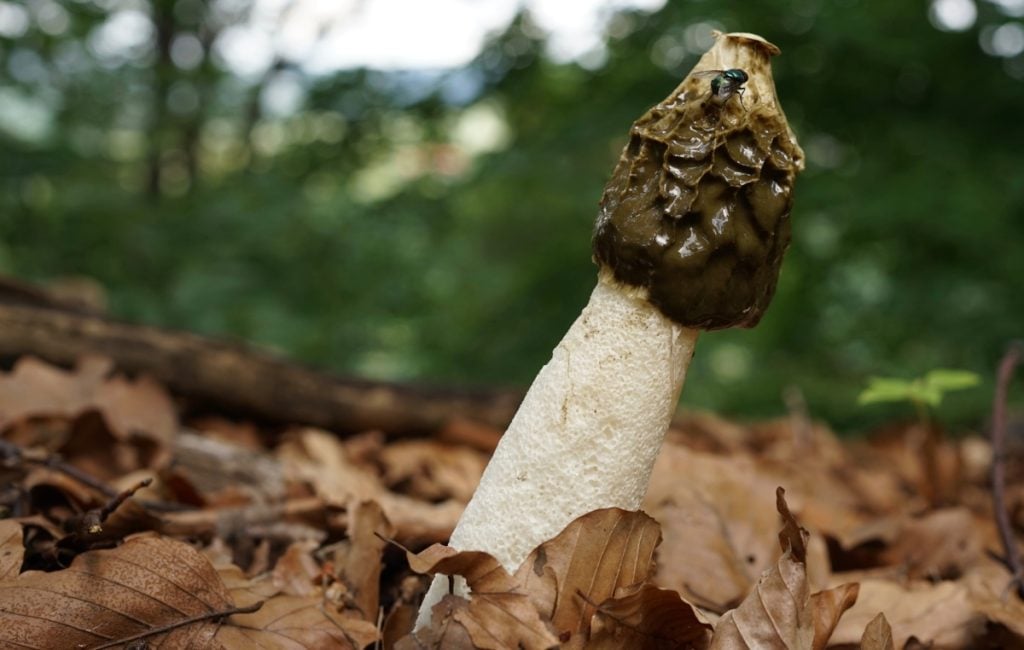
The common stinkhorn is part of a family of several different stinkhorns known for their foul odor and phallic shape when they’re mature.
They’re common in Britain, Ireland, Europe and North America from summer to late autumn.
You’ll find them growing in forests and mulched gardens where there’s lots of woody organic matter.
When a stinkhorn emerges, a smelly olive-green ‘gleba’ covers the cap and contains their spores.
They release a strong smell, described as smelling like rotting meat, that attracts insects who distribute the spores.
Despite their foul smell, they’re not usually poisonous. In some countries, people eat immature stinkhorns, which are called “eggs” because of their egg-like appearance.
Their smell does attract pets, and there have been reports of small dogs getting very sick after eating mature stinkhorns.
4. Mower’s Mushrooms (Panaeolus Foenisecii)

Mower’s mushrooms, also called haymaker’s or brown hay mushrooms, are common in lawns in summer throughout North America and Europe.
These small brown mushrooms have caps 0.4-1.2 inches (1-3cm) in size that vary in color from brown or orange-brown to light beige depending on how wet it is.
Mower’s mushrooms are inedible but not highly toxic, which is fortunate as they’re one of the mushrooms children frequently eat.
But, some look-alikes are very dangerous, and identifying small brown mushrooms is not easy.
So it’s probably best to remove any in your garden if you have children or pets.
5. Shaggy Ink Cap (Coprinus Comatus)

The shaggy ink cap, also known as the shaggy mane or lawyer’s wig, is another mushroom that often appears in backyards.
They first appear as white cylinders emerging from the ground, and then a bell-shaped cap, covered with scales, opens.
When this mushroom is ready to spore, its gills secrete an inky black liquid filled with spores that drips to the ground.
What makes shaggy ink caps even more unusual is the fact that a few hours after releasing their spores, they turn black and dissolve.
The same thing happens when you pick them.
Shaggy ink caps are edible when they’re young, but you need to cook them quickly before they turn into an inky mess.
Something to note is that some mushrooms in the same family as shaggy ink caps don’t mix well with alcohol, and when consumed with alcohol, produce a mild poison.
6. Fly Agaric (Amanita Muscaria)
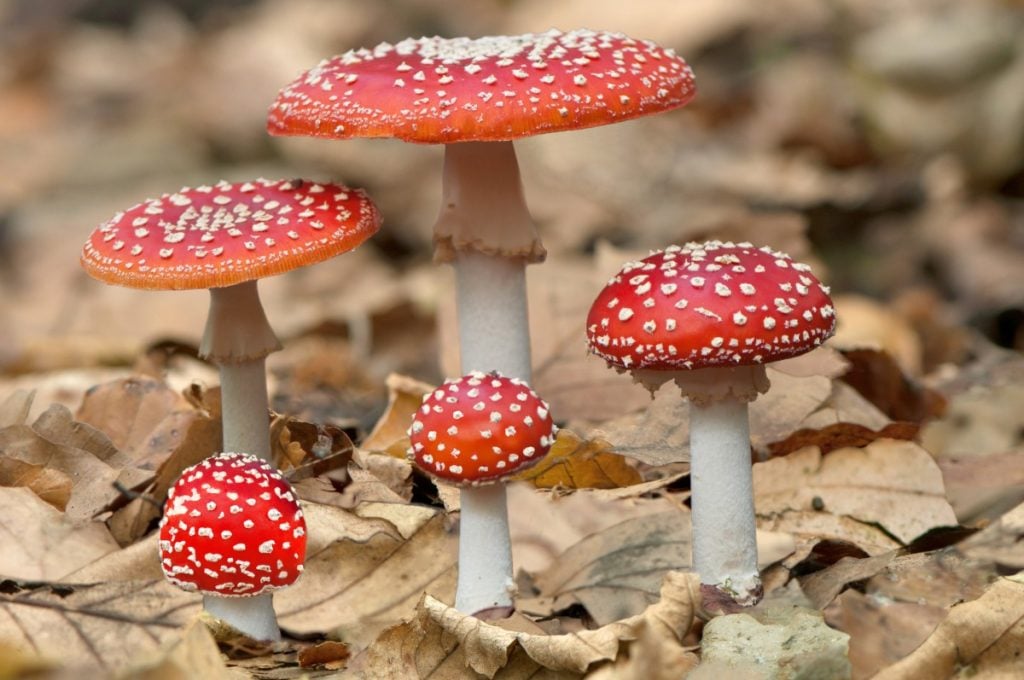
When you mention the word “toadstool,” the fly agaric mushroom is the one that comes to mind.
This large red or yellow mushroom is easily identified and has a white stem and gills and white scales on the cap.
Although classified as poisonous, there have not been many reported deaths from consuming it, and it’s more of a narcotic or hallucinogenic mushroom.
Fly agarics are fascinating because they’re poisonous, but in some countries, people eat them.
Before eating them, you need to boil them repeatedly to weaken the toxicity, and even then, they could still make you sick.
7. Fairy Ring Mushroom (Marasmius Oreades)
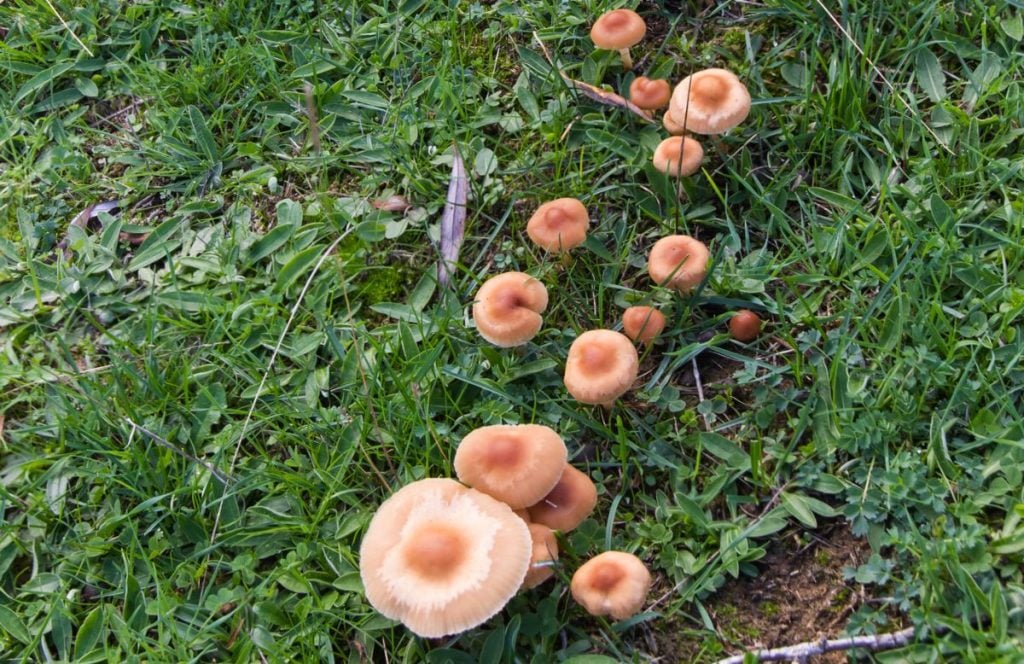
Also known as fairy ring champignons or scotch bonnets, fairy ring mushrooms are very common. They thrive in lawns and parks throughout North America, Europe, Britain and Ireland.
Fairy ring mushrooms occur in gradually expanding rings in lawns.
They have domed caps 0.8-2 inches (2-5cm) across and pale brown with wrinkled or grooved edges.
Their gills are free of the stem and white, turning pale tan or cream as the mushrooms mature.
Fairy ring mushrooms are edible and sweet-tasting and often used in soups, sauces and stews.
Be careful when identifying them as there are similar poisonous mushrooms.
8. Giant Puffball (Calvatia Gigantea)
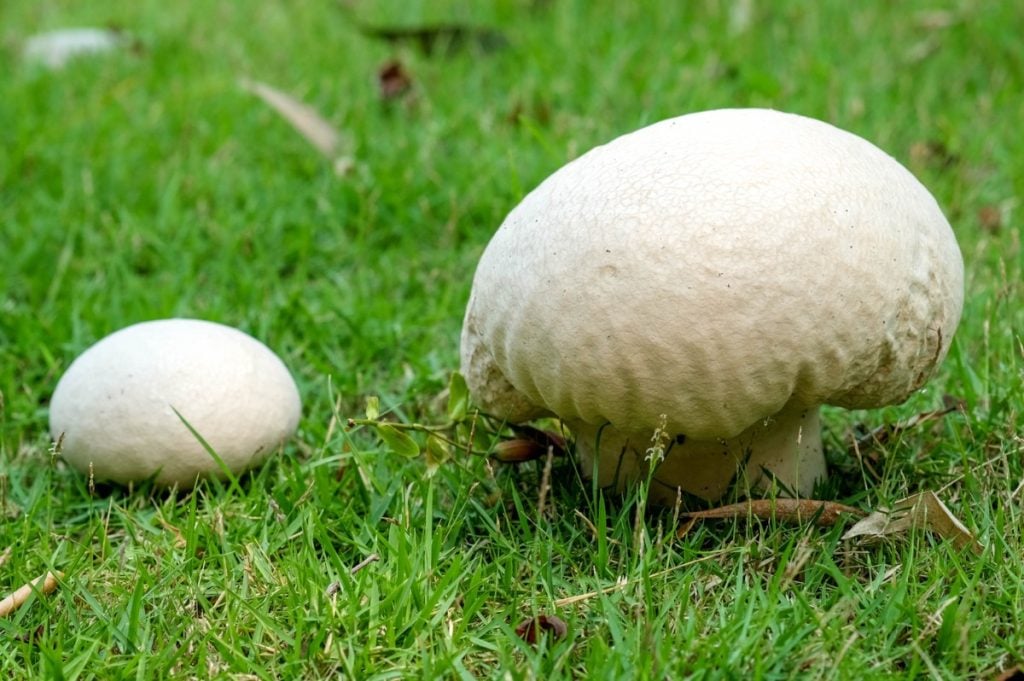
The Giant Puffball (Calvatia Gigantea) grows all over North America and other temperate regions worldwide and can get extremely large. It can grow anywhere from 8-24 inches (20-60 cm) wide and 3-12 inches (7.5-30 cm) high.
Unlike other mushrooms, puffballs grow as solid spheres without any gills, caps, or stems.
While some people are lucky enough to have giant puffballs in their backyard, smaller puffball species up to 2 inches (5 cm) in size are some of the most common backyard mushrooms.
There are several different species of puffballs, and they’re all edible when young and still white inside.
Correctly identifying young puffball mushrooms before you eat them is crucial as several poisonous Amanita mushrooms look like puffballs during their early growth stages.
To be sure you have the right mushroom, cut your suspected puffball in half. The flesh inside should be thick, hard and solid white.
If the inside contains a mushroom shape, gills or any black, brown, yellow, or purple coloration, discard the mushroom.
9. Green-Spored Parasol (Chlorophyllum Molybdites)
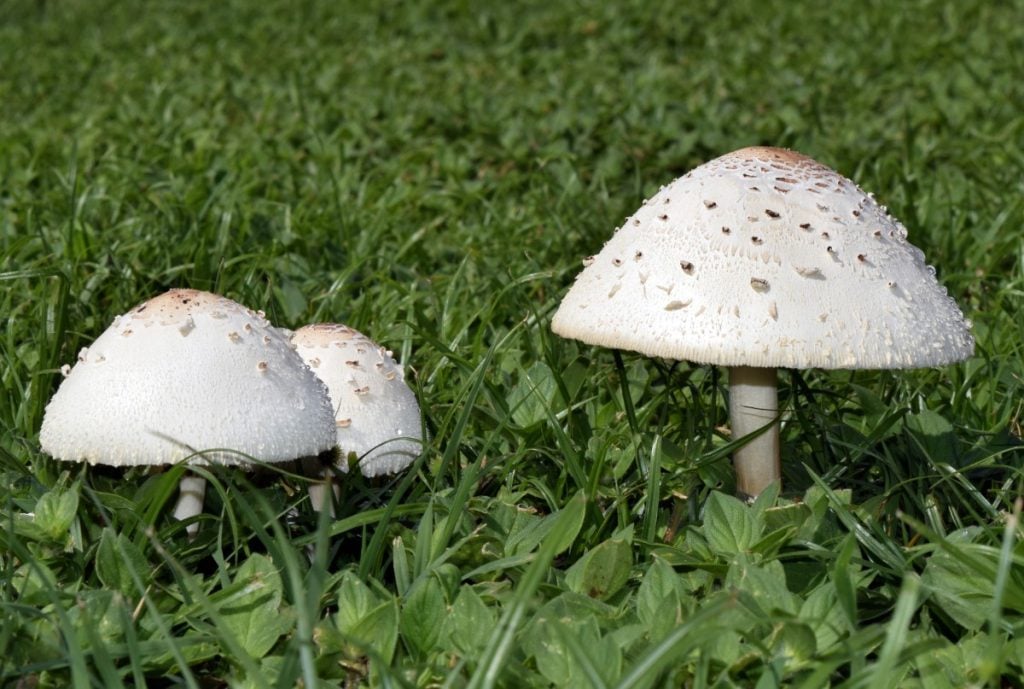
The green spored parasol, also called green lepiota or false parasol, is very common in garden beds and lawns during wet periods throughout spring, summer and autumn.
They appear in groups or fairy rings and have large white caps, 4-12 inches (10-30cm) in diameter.
Their caps have concentric circles of pinkish to brownish scales and gills that are white at first, becoming greenish to greenish-grey as their spores mature.
Green-spored parasols are easily mistaken for edible mushrooms as their appearance is similar, and they smell and taste mushroomy. But they’re extremely poisonous.
The most obvious feature that distinguishes them from edible mushrooms is the greenish gills of a mature green-spored parasol.
These are only a few of the mushrooms that thrive in urban conditions, and if the mushrooms in your backyard are not one of the above, no problem. Urban Mushrooms have put together a helpful index with pictures to help you identify the mushrooms in your backyard.
And, if you’re an app person, there are several excellent mushroom identification apps that can help you identify backyard mushrooms.
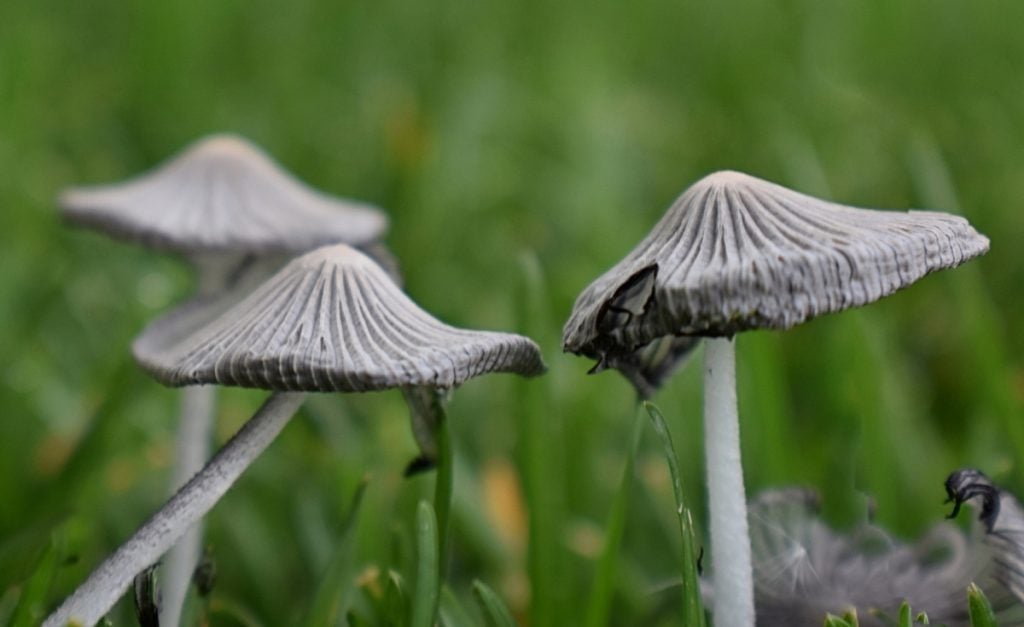
How to Tell if Backyard Mushrooms Are Poisonous
If you enjoy eating mushrooms, you may be wondering, “Are mushrooms in your yard edible?”
Some of your backyard mushrooms may be edible, but never eat a mushroom unless you can positively identify it and are 100 percent sure it’s safe.
Although less than five percent of known mushrooms are poisonous or of uncertain edibility, several toxic mushrooms do grow in backyards.
And, while most adults know not to eat unknown mushrooms, children and pets may sample them out of curiosity.
If you have small children or pets, it’s best to remove any unknown mushrooms that appear in your backyard.
To be safe, use gloves or a small spade, and pull or dig up as much of the mushroom as possible, not just the cap, and immediately put it into a plastic bag.
Close the bag tightly to prevent any spores from being dispersed, and place it in a bin. Make sure to wash your gloves, tools and hands thoroughly after handling unknown mushrooms.
Identifying mushrooms is not always easy, and many edible and poisonous mushrooms are very similar. People use the different parts of a mushroom to identify them.
Here are a few tips to help you tell if your backyard mushrooms are poisonous:
- Check for white gills: Look underneath the mushroom cap. If the mushroom has white gills, there is a good chance it’s poisonous, as most mushrooms with white gills are.
- Look for a partial veil or ring: Some mushrooms have rings around their stem, and although a few edible species have this feature, they’re common on poisonous mushrooms. To be safe, avoid any mushrooms with rings on their stems.
- Check the stem base for a volva: The very poisonous Amanita mushrooms all have rings and a volva at the bottom of their stems. The volva may be underground so if you are uncertain, dig at the base of the mushrooms to check.
There is an edible species of mushroom that has a volva. But because they’re so similar to death caps and destroying angels, it’s safer to avoid them.
- Is the mushroom red?: Mushrooms that have red on their caps or stems are either poisonous or hallucinogenic.
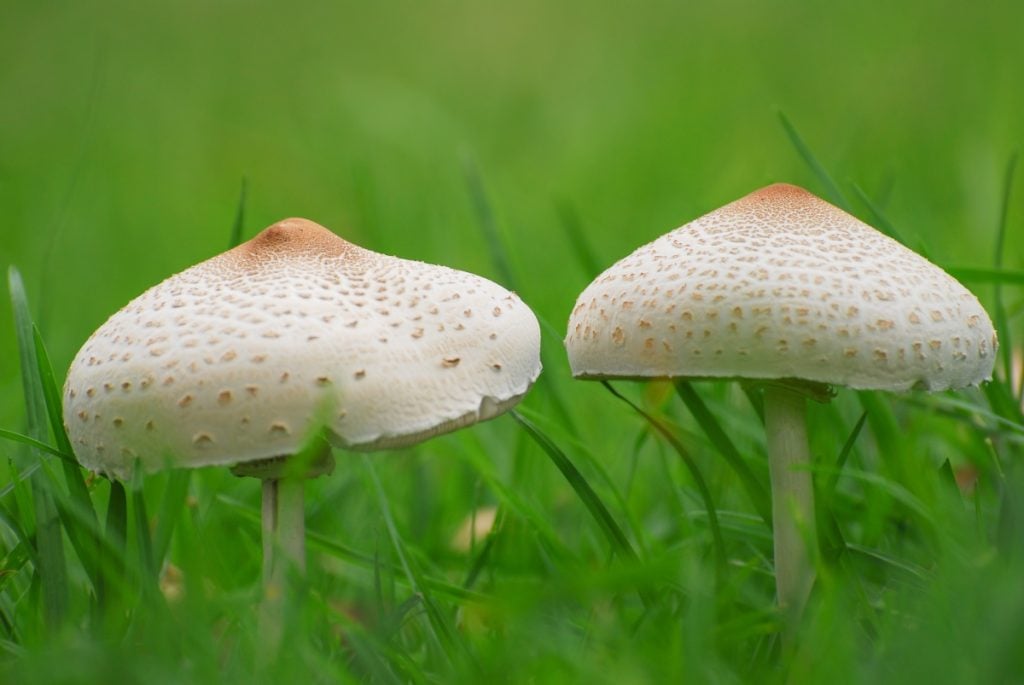
9 Ways to Prevent Mushrooms Growing in Your Backyard
Fungi play a vital role in your backyard, breaking down decomposing matter and creating healthy soil, and they often only last a short time.
So, if possible, make peace with them and enjoy these amazing organisms.
But, if you have small children and pets or suffer from mycophobia, you may want to prevent mushrooms from growing in your yard.
The best course of action is to make the environment in your backyard less appealing to mushrooms and reduce the fungi’s food sources.
Here are nine ways to keep backyard mushrooms from appearing so frequently and reduce their numbers:
1.Improve Soil Drainage
If your garden and lawn have patches of standing water or remain damp for long periods after rain, you may have compacted soil. Aerating helps to improve drainage, which decreases the moisture levels in these areas and discourages mushrooms.
2. Increase light and Air Circulation
Trim back and thin out trees and shrubs to let in more sunlight and increase air circulation in shady, damp areas.
3. Remove Wood and Tree Stumps
Remove any stumps, rotting branches or lumber to reduce the fungi’s food supply. If you have an area where there used to be a tree, even without a stump, the dead roots may still encourage mushroom growth.
4. Limit Irrigation
Sodden lawns encourage mushrooms, so limit irrigation to 1 inch (2.5 cm) of water a week. To establish a new lawn, you may need more water, but reduce the amount when you can.
5. Remove Excess Thatch in Lawns
Thatch is the tightly intermingled layer of living and dead leaves, stems, and roots that accumulates between the layer of growing grass and the soil.
If you have excess thatch, more than 0.5 inches(1.3 cm), it absorbs moisture and provides a food source for mushrooms. Dethatching your lawn can help to discourage mushrooms.
6. Clean up Pet Waste
Pet waste is another food source for mushrooms, so remove pet poop frequently.
7. Remove Immature Mushrooms
Picking or mowing mushrooms does not change the conditions in your yard or discourage growth.
But, if you pick or mow over mushrooms before they release their spores, you can prevent them from spreading.
If you have children or dogs, rather pick the mushrooms and safely discard them. Mowing may leave mushroom pieces that dogs and children could find.
8. Apply a Nitrogen-Rich Fertilizer
When you apply a nitrogen-rich fertilizer to your lawn, it speeds up the decomposition of organic matter in the soil.
Doing this reduces the fungi’s food source and can slow or even prevent fungal growth.
9. Balance the Bacteria and Fungi in Your Soil
Bacteria-rich soils have more leafy food present, and fungi-rich soils have more lignin-based foods like decaying wood and tree leaves.
If there is a neutral balance of fungi and bacteria in your soil, there’ll be fewer mushrooms.
If you have a lot of mushrooms adding more leafy material like grass clippings and vegetable leaves to your soil may help. Mulching with grass clippings is one way to do this.
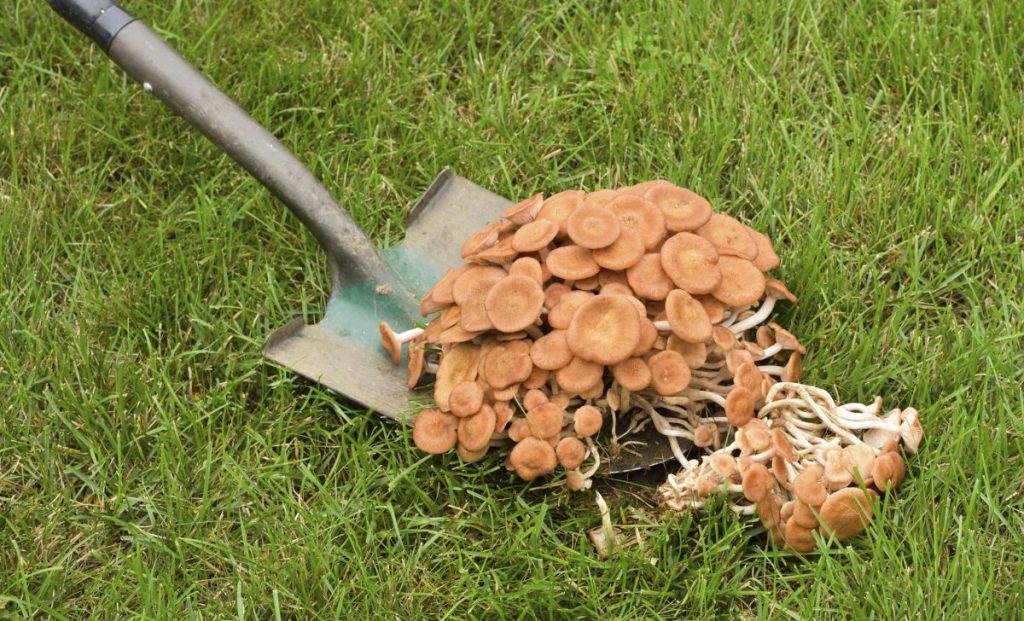
Natural Ways to Kill Mushrooms Growing in Your Backyard
It’s easier to reduce or prevent mushrooms by managing the conditions in your yard than to kill them.
Underground fungal mycelium networks are widespread and well hidden, so digging them up or using commercial fungicides will not remove them.
Fungicides often don’t work well on mushrooms because they don’t penetrate the soil deep enough to reach the mycelium and kill the fungus.
It’s also not advisable to use toxic chemicals and fungicides in areas where children or pets play.
But, if you really want to get rid of the mushrooms in your backyard, try these natural methods:
1. Vinegar
One way to kill off mushrooms growing in your yard is to spray them with a vinegar solution.
Household or cooking vinegar is usually not strong enough. Horticultural vinegar is very potent, so find some if you can and follow the directions to dilute it to the right strength.
Using a spray bottle will make it easier to apply the vinegar to the mushrooms but be careful where you spray as the vinegar may also kill the surrounding grass or plants.
2. Baking Soda
Baking soda is a gentler approach, and while it’s not a fungicide, it will increase the pH of the soil, inhibiting the mushroom’s growth.
Baking soda is not a permanent solution, but it is safe and effective. There are two ways you can go about applying baking soda to your mushrooms.
The first is in liquid form using a spray bottle. Mix two tablespoons of baking soda per gallon (5 liters) of water and stir until it’s dissolved. Spray the mixture onto the mushrooms and the surrounding soil.
Over time, this will reduce the mushroom’s growth and possibly even kill them.
The second method is to sprinkle baking soda directly onto mushrooms and surrounding soil and water it in.
You’ll need to repeat these methods regularly to see results, but they’re inexpensive and safe to use around pets and children.
Something to consider is that any significant changes in the soil’s pH level may inhibit the growth of nearby plants.
3. Soapy Water
Commercial dish soap is another easy solution to killing mushrooms in your backyard.
Mix one or two tablespoons of any commercial dish soap with up to three gallons (15 liters) of water.
With a screwdriver or something similar, poke holes in the soil around the mushrooms. Pour the soapy water over the mushrooms and into the holes.
Repeat the process several times a day for a week, and you’ll see a dramatic reduction in mushrooms.
For this to work, soapy water needs to get deep into the soil where the fungi live.
But, not everyone wants to get rid of mushrooms in their backyards.
For those of you who want an ongoing supply of fresh mushrooms, let’s take a look at the different ways you can grow mushrooms in your backyard.

How to Grow Mushrooms in Your Backyard
If you enjoy the umami taste and health benefits of mushrooms, you may be wondering if you can grow edible mushrooms in your backyard.
The answer is yes, and there are a couple of easy ways to grow mushrooms in your backyard.
Which you use will depend on your climate, mushroom type and how quickly you want your first harvest of mushrooms.
If you have a spot with moist conditions, you can grow species like the wine cap, oyster, morel or elm mushroom outdoors in a mushroom bed using wood chips and mushroom spawn.
You can also grow mushrooms on logs in your backyard. It takes longer to get your first harvest, but you can continue to harvest for many years until the mushrooms have totally decomposed the logs.
Some mushrooms commonly grown on logs are oyster, shiitake, lion’s mane and reishi mushrooms, but you can also try maitake, nameko, chicken of the woods, and pioppini.
Another fun way to grow reishi mushrooms is to grow them outdoors in soil using a fully colonized fruiting block.
Try experimenting to see which types of mushrooms grow best in your region and which methods work best for you.
Answers to Frequently Asked Questions About Backyard Mushrooms
Below you’ll find answers to some frequently asked questions about backyard mushrooms.
1. Are Mushrooms in Your Yard Bad?
Mushrooms in your yard are not bad and will usually go away relatively quickly once their life cycle is complete.
But, if you have small children or dogs, it’s a good idea to remove and discard any unknown mushrooms to prevent accidental poisoning.
2. Are Mushrooms a Sign of a Healthy Lawn?
Mushrooms are a sign of healthy soil with lots of organic matter, which usually also means a healthy lawn.
As the fungi break down the organic matter in the soil, they make nutrients available for themselves and other plants.
Healthy fungi-rich soils are a good sign and promote strong, healthy lawns, trees and shrubs.
3. Can You Eat Mushrooms From Your Backyard?
Some of the mushrooms in your backyard may be edible but as a rule, never eat a mushroom unless you can positively identify it as being edible and safe.
Several poisonous mushrooms look the same as edible mushrooms to the untrained eye.
4. Are Backyard Mushrooms Poisonous to Dogs?
Mushrooms that are poisonous for humans will also be toxic for dogs, but most common edible mushrooms will not be harmful.
If you see any poisonous mushrooms or mushrooms you are unsure about in your backyard, be sure to remove them as soon as possible to prevent poisoning.
For more information, read our article, “Can Dogs Eat Mushrooms? Learn What’s Safe for Your Pet.“
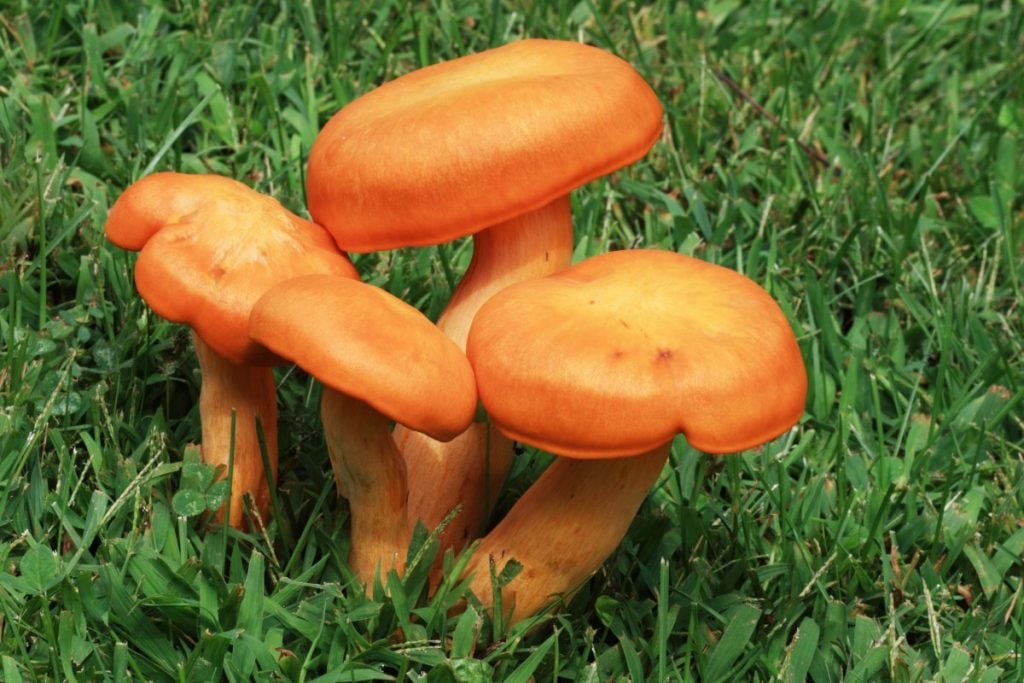
Final Thoughts
Not all backyard mushrooms are bad or dangerous, and some are even edible. What’s more, many people intentionally grow delicious edible mushrooms in their backyards.
When mushrooms pop up in your backyard in moist conditions, it’s an indication that you have healthy soil with lots of woody organic matter.
Changing the conditions in your backyard to be less favorable for mushrooms is one of the best ways to reduce their numbers over time. But, it isn’t necessary, unless you have children or pets to protect.
To learn more about mushrooms and how they reproduce, visit our Mushroom Education Hub.
